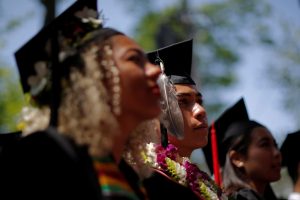Affirmative action is not the best path to diversity
April 11, 2019
Diversity means more than just race. Even though affirmative action — giving special consideration to minority college applicants — is useful for creating more racial diversity in historically white-dominated universities, it doesn’t specifically provide any assistance to lower-income students, which only feeds into elite schools’ ivory tower of affluence. Even though more minority students are being admitted to these universities, many of them still come from wealthy backgrounds like their peers.
To achieve true diversity, schools should replace race-based affirmative action with a system that looks at socioeconomic status instead, which will result in more diversity in every way, including racially, without excluding students from poor backgrounds.
Students from affluent families are at an advantage in admissions, regardless of their race, especially as tuition gets higher and competition gets stiffer. Schools in rich neighborhoods usually have better educational resources; for example, the Brookings Institution reported that high-income students were between 3 and 9 times more likely to have teachers educated at top colleges, compared to low-income students. This disconnect extends into course offerings and extracurricular activities. This is only the tip of the iceberg; lower-income students may also face barriers in transportation, home life, and employment. Lots of poor students excel anyway, but the cards are certainly stacked against them.
According to the Brookings Institution, lower-income students are significantly less likely to apply to top colleges than their wealthy counterparts, even if they are just as high-achieving, have equal grades and test scores and qualify for generous financial aid. The effects of this are evident nationwide. At Harvard, for example, the median family income was $168,000 in 2017, more than three times the national average, while Brown University, another Ivy League school, had a median income of $204,200. The rest of the Ivies fell in similar ranges, as did many other top schools. Even though these schools have seen an increase in racial diversity in the past few decades, their socioeconomic homogeneity persists.
Affirmative action is a well-meaning process, but it approaches the diversity problem incorrectly. On a large scale, African Americans and other minorities still face an immense amount of discrimination regardless of their economic background, from microaggressions — subtle comments or actions with prejudicial undertones — all the way to police brutality. Even so, affirmative action does not recognize any difference between a black student raised in affluence and a black student raised in poverty. In most cases, the obstacles people face in their lives are influenced more by their socioeconomic status than their race. This is not to discount all the barriers faced by minorities, but rather to highlight the drastic differences between an affluent upbringing and an impoverished one.
Adjusting admissions to account for socioeconomic status would likely increase colleges’ racial diversity just as affirmative action does. It’s no secret that our nation’s upper class is primarily white, so an influx of middle and lower-income students would lead to a natural increase in campus diversity, as these students are more likely to be minorities. That being said, colleges must also focus on offering more comprehensive financial aid, as steep tuitions can drive poorer students away before they even apply.
All in all, affirmative action is not the best method of increasing diversity at prestigious universities. Adjusting admissions for socioeconomic status instead could have the same effect on racial diversity without excluding thousands of middle and lower-income students from the opportunity of a high-quality college education.






